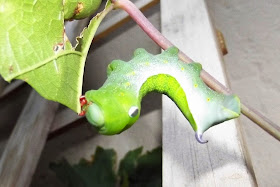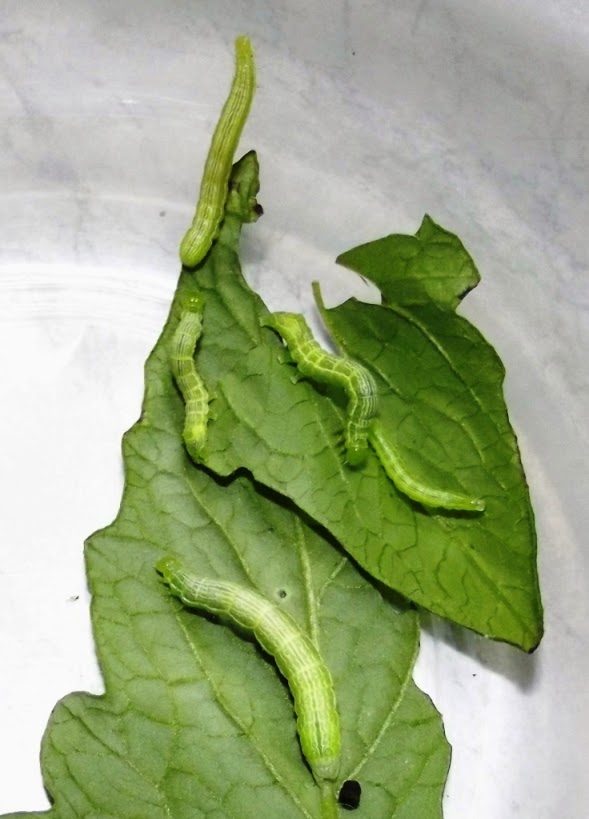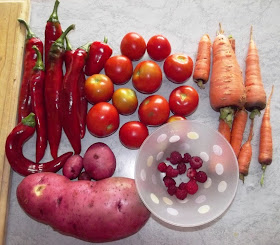Caterpillars at a
glance
Type of Damage
|
Chewing
|
Plant Symptoms
|
Holes in fruits, missing leaves, eaten leaves, ‘felled’
seedlings
|
Favourite Plant
|
Most food crops, especially tomatoes, fruit trees, grapes,
citrus, sweet potato, Solanum family
|
Control
|
Biological (predators: wasps, mantids, assassin bugs &
chickens), else physical removal
|
 |
| Caterpillar morphology |
Quick Intro
Caterpillars are regarded as one of the most destructive
insect pests that can devastate a food crop overnight! Some are specialists
only feeding on certain host plants whereas other are generalists and will feed
on anything green. Here I discuss some of the caterpillars that have cause havoc
in my garden and listed a few similar species to be on the lookout for.
Science Stuff
Caterpillars are the larval or immature stages of moths and butterflies;
these belong to the Lepidoptera order of insects. Sometimes caterpillars are
referred to as worms, but they are not true worms (Annelida), such as
earthworms.
Caterpillar is a derivative from the Latin words cattus (cat) and pilosus (hairy),
which basically translates to hairy cat J. Many caterpillars are
indeed hairy, which irritate the skin or mucous membranes of would-be
predators. Some are even toxic as they sequester poisons in their bodies from
compounds in their host plants. Toxic caterpillars display their toxicity
through bright colouration, whereas other relies on camouflage for protection.
 |
| Alice and the Caterpillar |
Interesting morphological characteristics: the last few segments on the caterpillar’s body have fleshy
sucker-like legs, known as prolegs, with which they cling to substrates. They
have silk glands, which are modified salivary glands mainly used to produce
silk for pupation and cocoon construction.
Habitat & Feeding
Adults (butterflies and moths) are generally nectar feeding,
whereas larvae are herbivorous and some species are insectivorous or detrivores.
The main objectives of caterpillars are to feed and grow.
They are gregarious and feed in groups to ensure safety. Caterpillars feed on
the underside of leaves, so be sure to check there when you are on the hunt. Caterpillars
moult several times throughout their life as they grow (4-5 times). Plump
caterpillars spin cocoons (silk) or pupate in chrysalis (non-silk). Here they
undergo metamorphosis into their final butterfly or moth stage.
Caterpillars occupy a wide variety of environments and many
have cosmopolitan distribution, which means you are likely not going to get
away from them…
Diseases
Generally caterpillars don’t transmit plant diseases, but
secondary bacterial, fungal or virus infections can set into affected sites
which, have been eaten or stung (fruits and leaves). Holes eaten in fruits can
become homes for other insects as well!
Citrus Swallowtail
Butterfly, Papilio demodocus
Caterpillars of this family have large, striking butterflies
of the Papilionidae family more commonly known as the Swallowtails. They have
several district immature stages with different appearances, but all feed on
citrus or members of the Rutaceae plant family (lemons, oranges and rue include
a few).
Early stage caterpillars are black and spiny with white or
orange patterns, this gives them a bird-dropping characteristic. Larger caterpillars
lose these markings and become green with the classic swallowtail morphology;
large eyespots on the head and thick fleshy body. All stages have a specialised
scent gland (technical term, osmeterium) which is concealed behind the head and
used as a defence mechanism. When disturbed they whip it out and try to stink
you away! They pupate in chrysalis suspended by silk threads.
I had several infestations, they seem to come in waves, over
the course of summer. They feed on any Rutaceae plant member, since I found
them on my lemons, limes and curry plant!
 |
| Citrus swallowtail caterpillar two immatures, Papillio demodocus |
 |
| Citrus swallowtail caterpillar, Papillio demodocus |
 |
| Citrus swallowtail caterpillar osmeterium, Papillio demodocus |
 |
| Citrus swallowtail butterfly, Papillio demodocus |
 |
| Citrus swallowtail butterfly, Papillio demodocus |
Similar species in South Africa:
Mocker swallowtail (Papilio
dardanus), Green-banded swallowtail (Papilio
nireus).
Other similar species:
Citrus butterflies (Papilio
anactus, Papilio eageus)
Green-striped
Hawkmoth (Grapevines), Theretra jugurtha
Hawk or sphinx moths are very easy to spot with their
streamlined bodes and large googly eyes. They are members of the Sphingidae
family and the adults are active at dusk and feed on nectar. Larvae are
hairless, bright green with a distinctive tail hook and pronounced eyespots. They
pupate in the soil or under leaf litter in chrysalis.
Hawk moth caterpillars are fruit lovers, feeding either on
fruiting bushes, vines or trees. They are often pests in orchard with damage to
grapevines being severe. I also had huge infestations of these guys that came
at my grapevine in waves! I only have one grapevine, so it goes to show how
well the adults can sniff out grapevines on which to lay eggs. Be vigilant for
these caterpillars if you have grapevines because they can destroy a plant
within a few days before you even notice it (especially when you have had a lot
of hail and you assume chewed leaves to be hail damaged leaves J).
 |
| Green striped Hawkmoth large caterpillar on grape vine, Theretra jugurtha |
 |
| Green striped Hawkmoth, Theretra jugurtha |
 |
| Green striped Hawkmoth, Theretra jugurtha |
Similar species in South Africa:
Cape Hawk/Grapevine Hawkmoth (Theretra capensis)
Other similar species:
Vine hawkmoth/silver-striped hawkmoth (Hippotion celerio)
 |
| Vine hawkmoth Hippotion celerio |
Tomato semi-looper, Chrysodeixis acuta
Owlet moths from the Noctuidae (Agrotidae) family are highly
destructive as adults and larvae. Night-flying adults pierce the skin of fruits
which likely succumb to rot. Larvae are highly destructive, feeding on leaves
and green fruits causing them to drop or rot or become hosts to other insects! Some
species pupate in the soil (chrysalis) whilst others pupate in cocoons spun
inside curled up leaves.
 |
| Spider has taken residence in damaged tomato fruits |
These are the biggest bane of my tomatoes, eaten leaves and
green fruits. They caused about 30% loss in my tomato fruits last year (summer
2013) due to fruit drop or rot. I patrol the tomatoes in summer and check the
underside of leaves and between developing fruits, pick of any culprits and
feed them to the chickens (- at least I get my tomatoes back in the form of
eggs J).
 |
| Silver U, Tomato semi-looper caterpillar, Chrysodeixis acuta |
 |
| Silver U, Tomato semi-looper pupae and moths, Chrysodeixis acuta |
Similar species in South Africa:
Golden Plusia (Trichopulsia
orichalcea), Tomato/Cotton Leaf Moth (Spodoptera
littoralis), African army worm (Spodoptera
exempta)
Other similar species:
Green looper (Chrysodeixis
eriosoma), Cabbage looper (Trichopulsia
ni)
Cutworm (Any food
crop seedling)
Cutworms are larvae from large groups of moths, Owlets
(Noctuidae), who burrow in the soil and sever you seedlings at ground level.
Morning reveals their night-time activity by a plot with ‘felled’ seedlings.
They are very destructive and wasteful, cutting down an entire stand of
seedlings overnight. There are several ways to stem their destruction through
adding collars (cardboard) around your plants, starting your plants in pots and
potting them out once they are large enough. Otherwise try potash, I think the
tiny sharp particles aren’t fun to burrow through see more on my Pest control page.
Starvation is another remedy, by leaving plot bare and removing weeds.
Birds are the main predator of caterpillars, seeing that
most wild (black-eyed bulbuls, flycatchers) and domesticated birds (chickens)
will do away at your vegetables as well – geese or ducks are more suited to
insect pest control as their damage to food crops are minimal.
On the insect side, caterpillars are a favourite of
parasitic wasps, but these are more suited to use in green houses (see Wasps post). Otherwise try to design your Insectary to attract paper wasps and
mantids to clean out your caterpillar problems.
 |
| Biological caterpillar control |
Chemical control likely would result in poisoning of other ‘higher’
insects, such as bees, spiders, mantids and wasps. Even organic solutions might
affect other insects as well. Therefore, after biological control, I recommend
removing them physically by hand and feeding them to the chickens (or put them
out for the other birds J).
Preventative tips
The most successful way of limiting caterpillars is by
reducing their host plant or making their host plant harder to find. Reduce
large stands of one crop type (monocultures) and inter-plant your crops. This
was very successful with my tomatoes, which I have had a reduction in crop loss
by inter-planting the tomatoes and planting them far apart (limits walkover of
caterpillars from one plant to the other).
 |
| Holes in tomato, caterpillar damage by Tomato semi-looper |
The best way to ID the caterpillar plaqueing your crops is to grab a few and 'incubate' them. Put them in a container with holes, feed them leaves and let it pupate. Photograph and take notes of the adult. The adult is the main ID stage for caterpillars. Most of the caterpillar here, I incubate in order to ID.
 |
| Green striped Hawkmoth large caterpillar , infestation incubation, Theretra jugurtha |
Something cool:
Earthwatch Institute
The Earthwatch Institute is a non-profit organisation that
promotes research in the nature environment. They allow member of the public
(volunteers) to join researchers on field expeditions when they collect samples
and field data. You can join a research group by booking online at their
website. Expeditions last several days to weeks and members of the public pay
for their participation. Money raised through these expeditions is used for further
research purposes.
 |
| Earthwatch |
They have several projects, including ones for documenting
caterpillars. They collect data on the biology and numbers of caterpillars in
order to study their interaction with other insects, especially their parasitic
wasps. The change in global weather pattern influence the rate of caterpillar
developments, which in turn shortens the window for the parasitic wasps to
locate, lay and develop in the caterpillar themselves. Researchers are
interested in studying these dynamics, one such project, includes documenting
the caterpillars of Costa Rica, more information on their website: EarthwatchInstitute.
 |
| "GRRR!" Green striped Hawkmoth large caterpillar on grape vine, Theretra jugurtha |
Related Posts/Pages
Recommended Books for pest control: Natural Pest and Disease Control
______________________________________________________________________________
Please share with fellow gardening enthusiasts via the various sharing buttons at the end of posts/pages! Else you can vote for posts through the Google reactions bar at the end of articles. To stay up to date I have provided several reader and social networking platforms with which to subscribe: Twitter, Pinterest, RSS Feed Reader or Email/Follow directly using the Blog Followers widget on the left hand side toolbar. Thank you for reading and please feel free to ask if questions arise - I appreciate comments and ideas too! 😆
_________________________________________________________________________________










